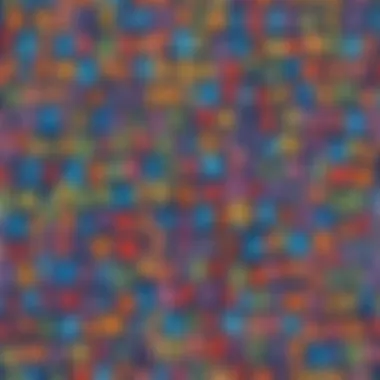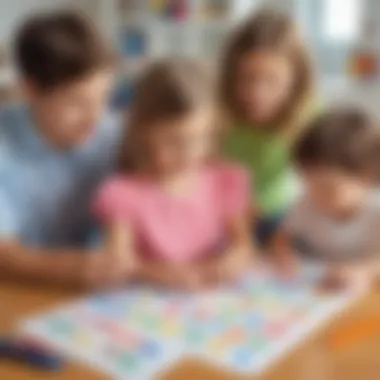Exploring Free Printable Alphabet Sheets: A Comprehensive Guide


Intro
In today's digital age, free printable alphabet sheets have become essential for early childhood education. They provide an accessible way for parents, educators, and caregivers to foster literacy skills in young children. These resources come in various formats, including coloring pages, flashcards, and worksheets. Such diversity allows for tailored learning experiences that meet different needs and preferences.
Understanding the educational benefits of these sheets is crucial. Alphabet sheets can significantly enhance a child's familiarity with letters and sounds, laying the groundwork for fluent reading and writing. Additionally, these materials can be easily integrated into both home and school environments, making learning engaging and interactive.
This guide aims to illuminate the myriad options available, practical usage tips, and the role these tools play in child development. By exploring these elements, you can better grasp how free printable alphabet sheets can be used effectively to unlock your child’s potential.
Fun Activities Ideas
Using printable alphabet sheets can lead to a variety of fun activities that enhance learning while keeping children engaged. Here are some ideas to consider:
Indoor Activities
- Alphabet Treasure Hunt: Hide alphabet sheets throughout the house. Ask children to find them and practice saying the letters.
- Letter Matching Game: Print multiple copies of letters. Have kids match uppercase to lowercase versions.
- Story Creation: Use alphabet sheets to encourage children to create short stories. Each letter can represent a character or event in the story.
Outdoor Adventures
- Nature Scavenger Hunt: Take alphabet sheets outside and find items that start with each letter. For example, A for apple, B for branch.
- Write in the Sand: Bring printable sheets and use them as guides. Have children write letters in the sand using sticks.
- Letter Art: Use leaves, twigs, or rocks to create letters outdoors, guided by alphabet sheets.
Arts and Crafts
- Alphabet Collages: Gather materials related to each letter and create collages based on printable sheets.
- Paint with Letters: Use printable alphabet sheets as stencils for painting letters on canvas.
- DIY Flashcards: Utilize the sheets to create custom flashcards. Kids can decorate them for a personal touch.
Science Experiments
- Letter Growth: Use alphabet sheets and plant seeds in shapes of letters. Monitor their growth while discussing letters and sounds.
- Volcano Letters: Create a baking soda and vinegar volcano. Write letters from the alphabet on paper to explain the reaction.
Cooking and Baking
- Letter Cookies: Make sugar cookies using alphabet shape cutters, allowing kids to decorate letters with icing.
- Smoothie Names: Write out children's names with letter sheets. Then, create colorful smoothies inspired by each letter.
- Sandwich Art: Use alphabet sheets as inspiration for creating sandwiches in letter shapes.
Tip: Engage children in interactive discussions while doing these activities to reinforce letter recognition and pronunciation.
By incorporating these activities, you provide enriching experiences that enhance the learning process. Whether indoors or outdoors, engaging with printable alphabet sheets can ignite a passion for learning and creativity in young minds.
Understanding Alphabet Sheets
In early childhood education, alphabet sheets serve a fundamental role in developing literacy skills. They can be a great support to both children and educators. Understanding what alphabet sheets are and how they function is crucial for leveraging their full potential.
Definition and Purpose
Alphabet sheets are educational tools designed to assist young learners in recognizing letters and understanding their shapes and sounds. Their purpose is twofold: to enhance literacy skills and to provide a hands-on approach to learning. Parents and educators use these sheets to lay a strong foundation in literacy that children can build on as they mature.
Using alphabet sheets encourages active engagement with the letters. Children are not just observers; they become participants in their own learning process. This hands-on interaction makes alphabet sheets an excellent resource for both at-home learning and classroom settings.
Types of Alphabet Sheets
Understanding the different types of alphabet sheets can help in selecting the right tools for individual learning objectives. Here, we explore four common types of alphabet sheets: Flashcards, Tracing Sheets, Coloring Pages, and Interactive Worksheets.
Flashcards
Flashcards are a popular choice for teaching letters. Their defining characteristic is simplicity. Each card typically features a single letter, often accompanied by an image related to that letter, such as an 'A' with an apple. This visual pairing aids memory retention.
The strengths of flashcards include their portability and versatility. They can easily be used in diverse settings, whether at home or on the go. However, one consideration is that flashcards may not engage some children for extended periods.
Tracing Sheets


Tracing sheets focus on handwriting skills. They usually provide outlines of letters, which children can trace with a pencil or crayon. This type of sheet is vital for developing fine motor skills and letter formation.
Their key feature lies in reinforcing the physical act of writing. Tracing sheets guide children through proper letter shapes. Although effective, the challenge might come when children need to transition from tracing to writing freehand.
Coloring Pages
Coloring pages add an artistic touch to learning letters. They often depict letters along with associated drawings, such as animals or objects. This makes understanding the concept of letters more enjoyable and engaging for children.
The notable aspect of coloring pages is that they stimulate creativity. Coloring makes the learning process more colorful and fun. However, it is essential to ensure the focus remains on letter recognition and not solely on the coloring activity.
Interactive Worksheets
Interactive worksheets move beyond traditional approaches by incorporating elements that require children to respond actively. They may involve matching letters to objects, filling in blanks, or other interactive activities.
The essential characteristic of interactive worksheets is their ability to foster active learning. This engagement can enhance retention and understanding of alphabet concepts. Nevertheless, it is vital to monitor that the tasks are age-appropriate to maintain interest and effectiveness.
In summary, recognizing the broad spectrum of alphabet sheets is instrumental for both educators and parents. By choosing the right type, they will not only facilitate letter recognition but also create a stimulating learning environment.
Benefits of Using Printable Alphabet Sheets
Printable alphabet sheets offer numerous advantages for young learners. They are not only valuable educational tools but also support various learning experiences. Their wide application makes them relevant for both home and classroom settings. The following points detail specific benefits of using these resources to enhance literacy skills in children.
Enhancing Early Literacy Skills
Early literacy skills form the foundation for reading and writing. Free printable alphabet sheets provide an engaging way for children to interact with letters and words. When children practice letters, they begin to recognize sounds and the connections between letters and words. Activities like tracing, coloring, and matching exercises deepen their understanding of letter shapes, sounds, and meanings. Children not only learn the alphabet, but also acquire phonemic awareness, which is essential in mastering reading skills.
Promoting Handwriting Development
Handwriting is a fundamental skill that influences how children communicate. By using printable alphabet sheets, children can practice their penmanship in a focused manner. Tracing the letters aids motor skills development as children learn proper letter formation. Printable sheets allow for repetition, which is crucial in developing muscle memory. Additionally, the variety in letter activities enables children to build confidence in their writing abilities.
Encouraging Letter Recognition
Recognizing letters is vital for early literacy and is often a primary goal for children in preschool and kindergarten. Printable alphabet sheets facilitate this recognition by presenting letters in various formats. From flashcards to coloring pages, these sheets introduce letters in an enjoyable way. When children engage with these resources, they start to identify letters outside of their printed context, such as in books or signs. This awareness is important as it builds a sense of normalcy around letters in their world.
"Letter recognition is a crucial step in literacy that sets children on the path toward successful reading."
Finding Free Printable Alphabet Sheets
Finding free printable alphabet sheets is a crucial aspect of making literacy learning accessible and engaging for children. In today's world, where educational resources are abundant yet often scattered, knowing where to locate these resources can save significant time and effort. Moreover, free options allow for budget-friendly learning, crucial for parents and educators alike.
The importance of free printable alphabet sheets lies not just in their availability but also in how they enhance the learning experience. These sheets provide varied educational tools that can improve letter recognition, writing skills, and ultimately, literacy. By exploring different sources for these printables, users can discover a wealth of materials tailored to meet diverse learning needs.
Reputable Online Sources
When searching for free printable alphabet sheets, reputable online sources play a primary role. Websites like Education.com or TeachersPayTeachers offer a variety of high-quality printable resources created by experienced educators. These sites often feature reviews and ratings, allowing parents and teachers to choose materials that best suit their educational goals.
Additionally, platforms such as Scholastic provide resources packed with educational insights, enabling parents and educators to access well-researched content.
Printable Options in Educational Sites
Many educational institutions and non-profit organizations host printable alphabet sheets for free. For example, site like PBS LearningMedia focuses on early education and provides engaging alphabet resources. Meanwhile, Starfall also offers a range of alphabet learning aids that encourage student participation through interactive features.
Exploring these sites ensures that users find diverse options, from simple tracing pages to more interactive worksheets suitable for various learning styles.
Community Contributions and Blogs
Community contributions and educational blogs are excellent additional resources for free printable alphabet sheets. Websites such as Reddit have communities where educators and parents share their favorite printable resources. Subreddits related to teaching and parenting often contain threads discussing useful sites and downloads.
Furthermore, blogs like The Measured Mom or Teach Preschool often offer free downloads as part of their content. Such blogs provide not only printable resources but also strategies for implementation, ensuring that parents and educators maximize their impact on children’s learning experiences.


Remember: Utilizing community resources often provides unique and creative approaches to teaching that standard educational sites may not capture.
Practical Tips for Utilizing Alphabet Sheets
Using free printable alphabet sheets effectively can significantly enhance a child's learning experience. To maximize the educational benefits of these resources, consider the following practical tips. These suggestions are designed for parents, educators, and caregivers who want to create an effective learning atmosphere that promotes literacy and engagement.
Creating a Structured Learning Environment
A structured learning environment is essential for fostering focus and attention. Keeping alphabet sheets organized and accessible can help children feel more comfortable and eager to learn. First, identify a dedicated space for learning. This quiet area should be free from distractions and equipped with necessary supplies, such as pencils, crayons, and scissors. These resources allow children to interact with the alphabet sheets meaningfully.
Next, develop a routine that includes specific times for using the sheets. Consistency helps children anticipate learning moments, promoting their cognitive readiness. For example, parents can designate 15 minutes each day for alphabet practice. Additionally, utilize storage solutions like binders or folders to keep the sheets neat and easy to find. Make sure to regularly rotate the materials to maintain interest and challenge levels.
Incorporating into Daily Activities
Integrating alphabet sheets into daily activities enhances learning without it feeling like a chore. Parents and educators can encourage phonetic awareness by pointing out letters in everyday situations. For instance, when reading a book, ask children to identify letters or words related to the images they see. This real-world application reinforces the concepts learned from the sheets.
Activities such as cooking can also lend themselves to alphabet learning. Use recipes to highlight measurement terms that start with specific letters. Encouraging children to read the ingredient names fosters excitement and engagement. Consider keeping a few sheets handy in the car. During trips, they can practice identifying letters on signs and license plates, turning travel time into productive learning moments.
Using Alphabet Sheets for Group Activities
Group activities promote collaboration and socialization while learning. Alphabet sheets can be used in classroom settings or playdates to encourage interaction among children. For instance, design games where children take turns tracing letters and then passing the sheets around. This not only aids in learning but also fosters teamwork.
Another effective group activity involves creating an alphabet scavenger hunt. Print various alphabet sheets and hide letters around the learning environment. Children can work together to find and collect the letters using their sheets as guides. This kinesthetic approach helps children learn while having fun.
By applying these practical tips, parents and educators can create an enriching environment that utilizes free printable alphabet sheets effectively, promoting literacy and nurturing young minds as they embark on their learning journeys.
Challenges and Solutions
In the journey of teaching children about the alphabet, several challenges can arise. Understanding these challenges is crucial for maximizing the potential of free printable alphabet sheets. This section highlights key obstacles and their possible solutions, benefiting parents and educators alike.
Maintaining Engagement
One of the primary challenges is keeping young learners engaged. Children have shorter attention spans, which can hinder the learning process. It is vital to incorporate various methods to sustain interest. Using colorful and interactive alphabet sheets could be one effective approach. For example, flashcards that allow children to draw or color can enhance interaction. Additionally, involving stories related to the letters can make learning immersive and fun.
"Engagement is key to effective learning; without it, even the best resources may go unused."
To maintain engagement, consider these strategies:
- Variety in Activities: Rotate between different types of alphabet sheets, like tracing and coloring sheets.
- Short Sessions: Keep learning sessions short and focused. This respects their attention span.
- Rewards System: Introduce a rewards system to encourage consistent effort and recognition.
Adapting to Various Learning Styles
Each child has a unique learning style, which can complicate the teaching process when using standard approaches. Some children may grasp concepts better through visual means, while others may benefit from auditory or kinesthetic methods. It is essential to assess the individual needs of learners and adapt accordingly.
Free printable alphabet sheets offer flexibility in this regard. For visual learners, colorful and illustrated sheets can enhance learning. For auditory learners, incorporating songs or rhymes related to the alphabet can be very effective. Similarly, kinaesthetic learners might benefit from activities where they can physically trace or build letters using materials like clay or sand.
To cater to different learning styles, educators and parents might consider these options:
- Customized Materials: Create or find resources tailored to specific styles.
- Interactive Learning: Use technology like educational apps that reinforce letter recognition in different engaging formats.
- Group Activities: Encourage group work where children can learn from one another, helping address various learning styles collectively.
Integrating Technology with Alphabet Learning
The integration of technology into alphabet learning represents a pivotal development in early education. It enhances the traditional methods of learning by offering digital resources that engage children more effectively. Technology can facilitate access to diverse teaching materials and cater to various learning preferences. Parents and educators can leverage these tools to create interactive and immersive learning experiences.
Digital Resources and Apps
Digital resources and apps play a crucial role in modern learning environments. They provide engaging content that captivates children's attention. Applications such as ABCmouse, Starfall, and Endless Alphabet offer interactive games that teach letters, sounds, and writing skills. The benefits of using these resources include:
- Interactive Learning: Children can interact with the content, improving retention and understanding.
- Diverse Formats: Different formats such as games, quizzes, and videos keep the learning process dynamic.
- Progress Tracking: Many apps provide progress reports, allowing parents and educators to monitor development.


The accessibility of these resources on various devices also means that learning can occur anywhere, whether at home or on the go. This flexibility supports continuous engagement with literacy skills.
Print and Digital Hybrid Approaches
Combining print and digital learning presents a comprehensive approach to alphabet education. By using printable sheets along with digital tools, educators can create a balanced learning experience for children. This hybrid method has several advantages:
- Reinforcement of Skills: Physical worksheets can reinforce what children learn in apps, aiding memorization.
- Tactile Learning: Some children benefit from the physical act of writing, which printables can provide.
- Variety: A mix of resources keeps learning fresh and prevents boredom.
In practice, this could involve using a printable tracing sheet alongside an app that teaches letter sounds. This approach not only caters to different learning styles but also enhances the overall effectiveness of alphabet education.
"Integrating technology with traditional learning methods can create a more holistic educational experience."
By embracing digital resources and hybrid approaches, parents and teachers can adapt to the evolving educational landscape while maintaining focus on core literacy skills.
The Role of Parents and Educators
The involvement of parents and educators is crucial in the learning process, particularly when it comes to young children's literacy development. Free printable alphabet sheets serve as an accessible resource that can be utilized effectively both at home and in educational settings. In this guide, we'll explore how collaboration between parents and educators can enhance the learning experience. Moreover, we'll examine the importance of monitoring progress to ensure that children are developing the necessary skills.
Collaboration in Learning
When parents and educators work together, the benefits for children are substantial. This collaboration creates a cohesive learning environment that reinforces the lessons taught in the classroom and at home. It ensures that children receive consistent messaging about the importance of literacy skills, which can greatly aid their understanding.
Here are key elements of effective collaboration:
- Sharing Resources: Parents and teachers can exchange ideas on which alphabet sheets have proven most effective. This can include discussing the types of sheets that engage children the most.
- Setting Shared Goals: Establishing common objectives helps to align efforts between home and school. When both parties agree on desired learning outcomes, children receive a clear path forward.
- Regular Communication: Keeping lines of communication open allows parents to stay informed about classroom activities related to literacy development. Also, it provides educators with insight into a child's progress at home.
By fostering a collaborative atmosphere, both parents and educators can contribute to a child's educational journey. This teamwork not only strengthens literacy skills but also builds a supportive network for the child emotionally and socially.
Monitoring Progress
Continuous assessment is integral to understanding how well children are developing their literacy skills. Parents and educators should regularly monitor progress in a structured manner. This allows for timely interventions when necessary and can help celebrate milestones achieved by the child.
Monitoring can include:
- Tracking Worksheets Usage: Observing how often children use alphabet sheets can provide insight into their engagement levels. Are they more interested in tracing sheets or coloring pages?
- Assessing Skill Acquisition: Regular evaluations should focus on letter recognition, writing skills, and overall comprehension. These assessments can be informal, such as through observation or structured review of worksheets.
- Seeking Feedback: Parents can provide feedback on their child's use of alphabet sheets during daily routines. Similarly, teachers can share observations from classroom activities to give a fuller picture of progress.
Regularly monitoring children's skills helps inform both parents and educators about the effectiveness of their approaches. This assessment can drive the necessary changes in materials used or strategies taught, fostering a more robust learning process.
"Collaboration and consistent monitoring can transform how children engage with literacy, ensuring that they develop a strong foundation for future learning."
Engaging thoughtfully in these aspects can make a significant difference in a child's literacy development. By understanding the role of both parents and educators, we can collectively enhance the educational experiences for young learners.
Future Trends in Alphabet Learning Resources
As the landscape of education changes, so do the resources we use to teach children foundational skills like literacy. Future trends in alphabet learning resources are vital in shaping how children acquire reading and writing skills. The emphasis now is not only on the resources themselves but also on their adaptability and the engagement strategies they employ. This section will explore how these trends are redefining the approach of parents and educators towards alphabet learning.
Evolving Educational Standards
The educational landscape is in constant evolution. Standards are adapting to incorporate research on how children learn best. Alphabet sheets are not left behind. They are becoming more aligned with new educational frameworks that emphasize personalized learning.
Modern alphabet sheets are designed considering various learning styles. They include visual, auditory, and kinesthetic elements. This is to cater to every type of learner. For example, instead of simple tracing letters, new sheets might integrate images that relate to the sound of each letter.
Engagement is central. Traditional methods are giving way to resources that invite wonder and exploration. New standards advocate for interactive content that maintains a child’s curiosity. This includes elements like QR codes linking to educational games or animated tutorials that teach pronunciation.
The Role of Gamification
Gamification is a trend that is fundamentally reshaping alphabet learning resources. It incorporates game-like elements into educational tools to increase learner confidence and motivation. This trend recognizes that children engage more deeply when they feel they are playing rather than studying.
For instance, some printable alphabet sheets now feature reward systems. Kids can track their progress, earning stars or fun stickers as they master each letter. There’s also the incorporation of challenges that stimulate friendly competition, either against oneself or with peers. These aspects of gamification create a playful atmosphere around learning, making it less intimidating.
Additionally, gamified elements appeal to a broad range of children, making learning more inclusive. It can help break down complex tasks into manageable segments. This helps young learners gradually build skills they can use later in more advanced reading and writing tasks.
As gamification becomes prevalent, the way in which children approach learning shifts positively. Children who learn through games often show greater retention of information and higher levels of enjoyment in the process.
In summary, the future of alphabet learning resources is marked by evolving educational standards and the increased use of gamification. Both trends create an engaging, adaptable environment, fostering foundational literacy skills in young learners. Parents and teachers must remain attuned to these developments to effectively support children in their learning journey.



